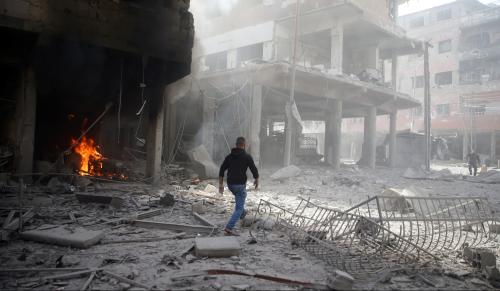In April 16’s Wall Street Journal, former U.S. ambassador to Syria Ryan Crocker and I suggest how President Trump can build on the recent U.S.-U.K.-French reprisal attacks against Syrian chemical weapons facilities. In our view, this should be with an eye toward developing a fuller strategy for the Syria conflict that could prove at least moderately effective and durable at modest cost. The ideas build on related writings that Ambassador Crocker and I have done recently with Brookings nonresident scholar Pavel Baev of PRIO in Oslo. Specifically, we lay out the following four elements for a broad strategy, some of which build on ideas the Trump administration has itself supported at times:
1Help local allies in Syria hold their ground. As Crocker and I argue, this objective may require small deployments of U.S. forces to certain sectors of the country—for specific purposes like being able to call in airstrikes if partners are threatened, or protecting aid workers who are helping reconstruct these areas so refugees can start to return.
2Take advantage of the threat of further U.S. military operations. Bashar Assad should be told that any attack by his forces, or by Iranian-controlled militias, on U.S. and allied forces in the sectors of Syria where they operate will be met with swift, unannounced retribution. Next time the U.S. could up the ante. Even targets within Iran should not be off limits, depending on the provocation.
3Establish a more realistic political vision for the country—one that no longer seeks Mr. Assad’s immediate removal. To be sure, as Crocker and I assert, he is a monster and at some point he must go. But the West must accept that Assad would insist on a major hand in choosing his successor through a managed transition. The international community has some leverage in shaping the choice, including by ensuring that viable Kurds and other Sunnis are in a future cabinet, but it would be his choice.
4Develop a better answer to the Kurdish question to secure Turkey’s cooperation. In addition to promoting a ceasefire between Turkey and the Kurdish PKK, the U.S. and its allies should condition most aid to Kurds in Syria on a return of the heavier weapons given to them to fight ISIS, once that battle is truly over. Washington should declare that it will never support an independent Kurdish state in Syria (or elsewhere) and that it opposes a single, formal Kurdish autonomous region within Syria. To access aid, Syrian Kurds should also be required to allow non-Kurdish towns within their areas of control a degree of additional local autonomy.
In all of this, as we wrote, America and its international partners have a major advantage: money. Most of the $100 billion or so in financing that Syria will ultimately need to rebuild can only be delivered by the United States and its allies. Western funds should not flow to Assad or the regions he controls until he steps down. The only exception would be limited amounts of food and medicine for humanitarian purposes, once he starts respecting cease-fires and stops massacring innocents.
Even with these improvements, stabilizing Syria will be difficult and take time. But we conclude that America’s core goals of stability, recovery and safety for Syria’s displaced, limits on Assad’s and Iran’s influence, and prevention of the emergence of an ISIS successor could be brought at least partly within reach with a coherent and comprehensive strategy.





Commentary
4 essential elements of a U.S. strategy on Syria
April 17, 2018